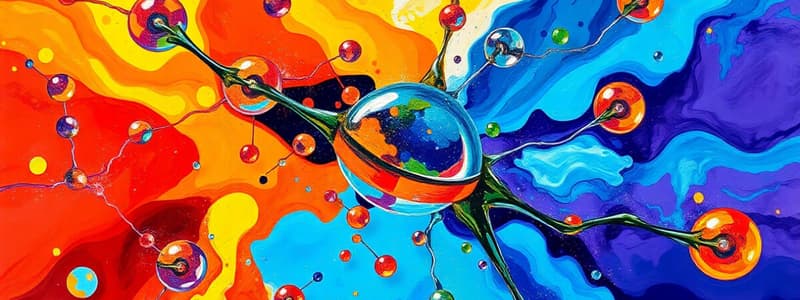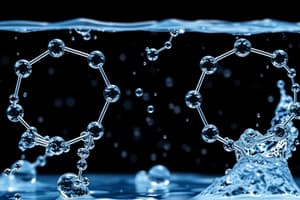Podcast
Questions and Answers
What is the primary role of hydrolysis in protein digestion?
What is the primary role of hydrolysis in protein digestion?
- To form new peptide bonds between amino acids
- To separate peptides into individual amino acids (correct)
- To prevent the breakdown of proteins
- To create enzymes that break down proteins
What happens during the induced fit mechanism of enzyme action?
What happens during the induced fit mechanism of enzyme action?
- The enzyme changes shape to enhance substrate binding (correct)
- Enzyme activity is reduced due to denaturation
- Substrates are rigidly held in place
- Products are released before the reaction occurs
How do enzymes affect the activation energy of a reaction?
How do enzymes affect the activation energy of a reaction?
- They increase the activation energy, slowing reactions
- They have no effect on activation energy
- They only affect activation energy at high temperatures
- They lower the activation energy, speeding up reactions (correct)
Which condition can lead to the denaturation of an enzyme?
Which condition can lead to the denaturation of an enzyme?
What is a characteristic of competitive inhibition?
What is a characteristic of competitive inhibition?
What role do cofactors and coenzymes play in enzyme activity?
What role do cofactors and coenzymes play in enzyme activity?
Which process enhances substrate reactivity during catalysis?
Which process enhances substrate reactivity during catalysis?
What occurs after the enzyme catalyzes a reaction?
What occurs after the enzyme catalyzes a reaction?
Which carbohydrate is primarily a source of energy for cells?
Which carbohydrate is primarily a source of energy for cells?
What is the largest organelle in the cell?
What is the largest organelle in the cell?
Which disaccharide is composed of glucose and fructose?
Which disaccharide is composed of glucose and fructose?
What does the nucleus primarily store?
What does the nucleus primarily store?
What is the primary function of the nucleolus?
What is the primary function of the nucleolus?
What is the primary function of cellulose in plants?
What is the primary function of cellulose in plants?
Dehydration synthesis differs from hydrolysis in that dehydration synthesis:
Dehydration synthesis differs from hydrolysis in that dehydration synthesis:
What molecular shape does water (H₂O) have?
What molecular shape does water (H₂O) have?
Which of the following is NOT an example of passive transport?
Which of the following is NOT an example of passive transport?
What causes the partial negative charge in a water molecule?
What causes the partial negative charge in a water molecule?
Which of the following carbohydrates is classified as an oligosaccharide?
Which of the following carbohydrates is classified as an oligosaccharide?
Which statement about osmosis is correct?
Which statement about osmosis is correct?
What role does the sodium-potassium pump play in the cell?
What role does the sodium-potassium pump play in the cell?
What elements are the backbone of carbohydrate molecules?
What elements are the backbone of carbohydrate molecules?
What type of bond occurs between the oxygen atom of one water molecule and the hydrogen atom of another?
What type of bond occurs between the oxygen atom of one water molecule and the hydrogen atom of another?
Which of the following describes the process of endocytosis?
Which of the following describes the process of endocytosis?
Which property of water is primarily a result of hydrogen bonding?
Which property of water is primarily a result of hydrogen bonding?
Which statement accurately describes hydrolysis?
Which statement accurately describes hydrolysis?
Which function is associated with the nucleoplasm?
Which function is associated with the nucleoplasm?
How do polar covalent bonds contribute to the properties of water?
How do polar covalent bonds contribute to the properties of water?
Glycogen differs from starch primarily in:
Glycogen differs from starch primarily in:
What role does water's polarity play in biological systems?
What role does water's polarity play in biological systems?
What is an effect of water's ability to surround and separate ionic compounds?
What is an effect of water's ability to surround and separate ionic compounds?
What characterizes the electron sharing in polar covalent bonds?
What characterizes the electron sharing in polar covalent bonds?
What is the main energy source required for active transport?
What is the main energy source required for active transport?
Which of the following is an example of passive transport?
Which of the following is an example of passive transport?
In which type of environment does the solvent move from a lower solute concentration to a higher solute concentration during osmosis?
In which type of environment does the solvent move from a lower solute concentration to a higher solute concentration during osmosis?
Which factor does NOT affect the rate of diffusion?
Which factor does NOT affect the rate of diffusion?
Which type of endocytosis is primarily utilized by immune cells to engulf bacteria?
Which type of endocytosis is primarily utilized by immune cells to engulf bacteria?
What typically serves as the most common solvent in biological systems?
What typically serves as the most common solvent in biological systems?
Which scenario best describes a hypertonic environment for a cell?
Which scenario best describes a hypertonic environment for a cell?
What is the primary difference between active and passive transport in terms of the direction of movement?
What is the primary difference between active and passive transport in terms of the direction of movement?
Flashcards are hidden until you start studying
Study Notes
Water Polarity and Bonding
- Water (H₂O) has a bent molecular shape, contributing to its unique properties.
- Oxygen's electronegativity causes the oxygen atom to have a partial negative charge, and hydrogen atoms a partial positive charge.
- Unequal sharing of electrons leads to a dipole moment, with one end being slightly negative and the other slightly positive.
- Polarity enables water to form hydrogen bonds, which are fundamental for high boiling points and solubility.
Types of Water Bonds
- Hydrogen Bonds: Weak attractions between the slightly positive hydrogen of one water molecule and the slightly negative oxygen of another, impacting properties like surface tension.
- Polar Covalent Bonds: Unequal sharing of electrons between hydrogen and oxygen within the water molecule, contributing to its polar nature.
- Ionic Interactions: Water surrounds and separates ions in ionic compounds, aiding in dissolving substances and acting as a universal solvent.
Functions of Water in the Human Body
- Water acts as a proton donor (acid) and plays a role in maintaining acidity in solutions.
- Essential for forming peptide bonds in protein synthesis.
Carbohydrates Overview
- Monosaccharides: Single sugar units like glucose (energy source), fructose (sweeter, found in fruits), and galactose (part of lactose).
- Disaccharides: Combinations of monosaccharides, e.g., sucrose (table sugar), lactose (milk), and maltose (from starch digestion).
- Oligosaccharides: Short chains of sugar units such as raffinose found in beans and vegetables.
- Polysaccharides:
- Starch (glucose storage in plants, e.g., potatoes).
- Glycogen (glucose storage in animals, mainly in liver and muscles).
- Cellulose (structural component of plant cell walls, not digestible by humans).
Composition of Carbohydrates
- Composed mainly of carbon (C), hydrogen (H), and oxygen (O) with a typical H:O ratio of 2:1.
Dehydration Synthesis vs. Hydrolysis
- Dehydration Synthesis: Removes a water molecule to join smaller molecules into larger ones, like forming disaccharides from monosaccharides.
- Hydrolysis: Adds a water molecule to break larger molecules into smaller units, as seen in starch breaking down into glucose.
Examples of Disaccharides
- Sucrose: Glucose + Fructose; common table sugar.
- Lactose: Glucose + Galactose; found in milk.
- Maltose: Two glucose units; found in malted foods.
Glycogen vs. Starch
- Both serve as glucose storage, but glycogen is used in animals while starch is used in plants.
Enzyme Functionality and Activation Energy
- Substrate Binding: Specific active sites on enzymes accommodate substrates to form enzyme-substrate complexes.
- Induced Fit: Enzymes may change shape upon binding to enhance interaction.
- Catalysis Mechanisms: Enzymes lower activation energy, allowing reactions at lower temperatures and faster rates.
- Product Release: Following reactions, products are released and enzymes return to initial state.
Factors Hindering Enzyme Activity
- Denaturation: Extreme temperatures or pH levels can alter enzyme structure.
- Inhibition: Competitive (blocking active site) and non-competitive (changing shape) inhibition reduce effectiveness.
- Cofactor/Coenzyme Availability: Lack of necessary helpers can inhibit enzyme function.
Nucleus and Nucleolus Functions
- Nucleus: Largest organelle, stores DNA and nucleoplasm, site of DNA replication and transcription.
- Nucleolus: Produces rRNA and assembles ribosomal subunits crucial for protein synthesis.
Passive Transport Examples
- Diffusion: Movement from high to low concentration (e.g., gas exchange).
- Facilitated Diffusion: Uses proteins to help molecules cross membranes (e.g., glucose).
- Osmosis: Water movement across semipermeable membranes.
- Filtration: Movement driven by hydrostatic pressure (e.g., kidney filtration).
Active Transport Examples
- Sodium-Potassium Pump: Transports Na⁺ out and K⁺ into cells, utilizing ATP.
- Proton Pump: Moves protons across membranes, important for digestion.
- Endocytosis: Cell membrane engulfs materials to form vesicles; includes phagocytosis (large particles) and pinocytosis (liquids).
- Exocytosis: Vesicles release contents outside the cell.
Active vs. Passive Transport Differences
- Energy Requirement: Active transport requires energy (ATP), passive does not.
- Direction of Movement: Active transport moves against gradients, while passive moves with gradients.
- Types of Transport: Active includes pumps and vesicular transport; passive includes diffusion and osmosis.
- Specificity: Active transport is often specific to certain substances; passive is less selective.
Factors Affecting Rate of Diffusion
- Concentration Gradient: Greater differences enhance diffusion speed.
- Temperature: Higher temperatures increase molecular movement.
- Molecular Size: Smaller molecules diffuse faster.
- Medium: Gases diffuse quicker than liquids; liquids quicker than solids.
- Surface Area: Larger areas increase diffusion potential.
- Distance: Shorter distances facilitate rapid movement.
Solvent vs. Solute
- Solvent: Dissolves solutes, usually present in greater amounts (e.g., water).
- Solute: Dissolved in solvent, present in lesser amounts (e.g., salts).
- Movement in Osmosis: During osmosis, the solvent (water) moves to balance solute concentrations across membranes.
Osmotic Environments
- Isotonic: Equal solute concentrations; no net movement.
- Hypotonic: Lower solute concentration outside; water moves in, possible cell bursting.
- Hypertonic: Higher solute concentration outside; water moves out, causing cell shrinkage.
Studying That Suits You
Use AI to generate personalized quizzes and flashcards to suit your learning preferences.




